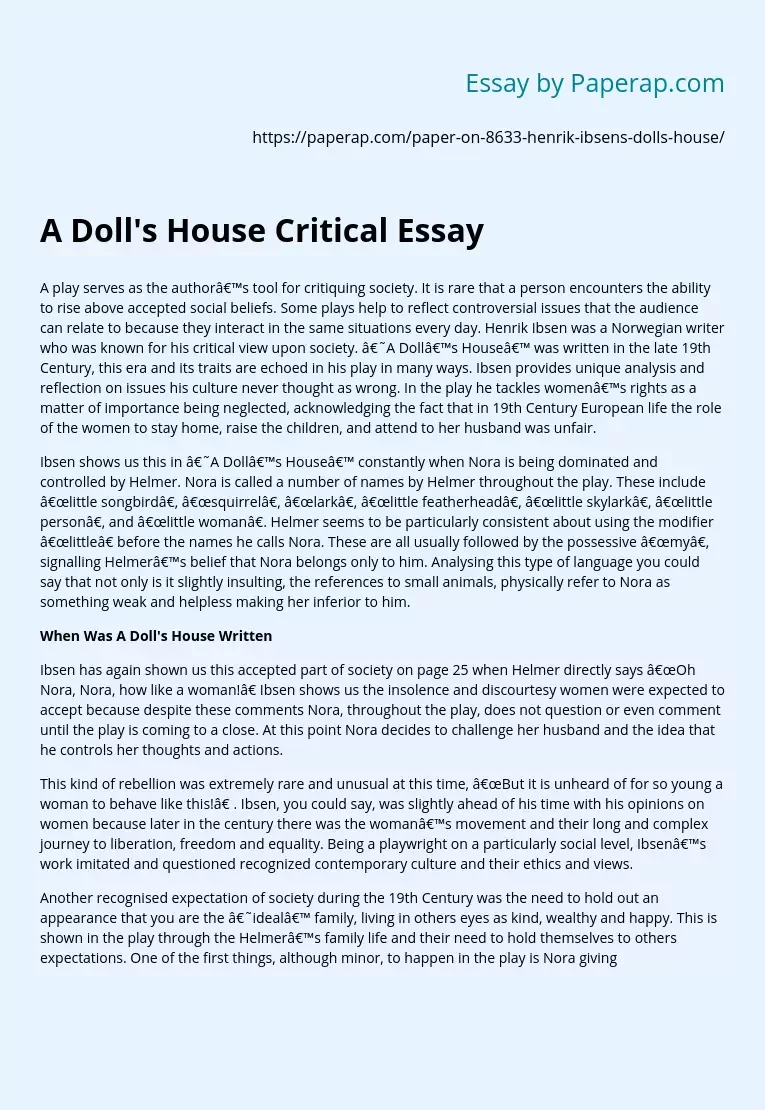A Doll's House Critical Essay
A play serves as the author’s tool for critiquing society. It is rare that a person encounters the ability to rise above accepted social beliefs. Some plays help to reflect controversial issues that the audience can relate to because they interact in the same situations every day. Henrik Ibsen was a Norwegian writer who was known for his critical view upon society. ‘A Doll’s House’ was written in the late 19th Century, this era and its traits are echoed in his play in many ways.
Ibsen provides unique analysis and reflection on issues his culture never thought as wrong. In the play he tackles women’s rights as a matter of importance being neglected, acknowledging the fact that in 19th Century European life the role of the women to stay home, raise the children, and attend to her husband was unfair.
Ibsen shows us this in ‘A Doll’s House’ constantly when Nora is being dominated and controlled by Helmer.
Nora is called a number of names by Helmer throughout the play. These include “little songbird”, “squirrel”, “lark”, “little featherhead”, “little skylark”, “little person”, and “little woman”. Helmer seems to be particularly consistent about using the modifier “little” before the names he calls Nora. These are all usually followed by the possessive “my”, signalling Helmer’s belief that Nora belongs only to him. Analysing this type of language you could say that not only is it slightly insulting, the references to small animals, physically refer to Nora as something weak and helpless making her inferior to him.
When Was A Doll’s House Written
Ibsen has again shown us this accepted part of society on page 25 when Helmer directly says “Oh Nora, Nora, how like a woman!” Ibsen shows us the insolence and discourtesy women were expected to accept because despite these comments Nora, throughout the play, does not question or even comment until the play is coming to a close. At this point Nora decides to challenge her husband and the idea that he controls her thoughts and actions.
This kind of rebellion was extremely rare and unusual at this time, “But it is unheard of for so young a woman to behave like this!” . Ibsen, you could say, was slightly ahead of his time with his opinions on women because later in the century there was the woman’s movement and their long and complex journey to liberation, freedom and equality. Being a playwright on a particularly social level, Ibsen’s work imitated and questioned recognized contemporary culture and their ethics and views.
Another recognised expectation of society during the 19th Century was the need to hold out an appearance that you are the ‘ideal’ family, living in others eyes as kind, wealthy and happy. This is shown in the play through the Helmer’s family life and their need to hold themselves to others expectations. One of the first things, although minor, to happen in the play is Nora giving the Porter a pound after he asks for a shilling, our first impressions are of her generosity, but we soon after discover that Nora knows she cannot afford this with her threatening financial situation.
Therefore to a certain extent this was not an act of kind-heartedness but more of the realisation of the probable neglect from society if they did not portray themselves as the ‘ideal’ family to others. Ibsen shows us a second example of social acceptance with Krogstad and his fear of unemployment. Krogstad is obviously desperate not to experience this, most likely due to the fact that he would be exiled from society and thought of as unsuccessful if he could not acquire work. Ibsen was able to write about this situation extremely accurately because in 1836 his father, who had been prosperous until that time, went bankrupt, in that culture and at that time it proved as a disgrace profound enough to affect him and his children for the rest of their lives.
Ibsen had a slightly alternative style of writing, compared to other play writes at the time, trying to be as realistic and precise as possible. After the 1848 revolution, a new modern perspective was starting to appear in the literary and dramatic world, challenging the romantic tradition. Ibsen was mastering and popularising the realist drama derived from this new perspective, ‘A Doll’s House’ could easily have been just another modern play with another comfortable moral lesson. However, when Nora tells Helmer that they must sit down and “discuss all this that has been happening between us”, the play diverges from the traditional form. Ibsen raises issues which have not previously been considered, but not in a point blank way, instead he manages to make ‘A Doll’s House’ interesting and thought provoking.
Ibsen’s major target audience was the middle class, as he was brought up in similar circumstances he was able to portray the thoughts and feelings of middle class life accurately. Ibsen chose to use colloquial language to emphasize this style of realism and to help relate to his audience. Despite this Ibsen also managed to tactfully reveal that the middle class did in fact have some flaws, his realist drama disregarded a number of things, for example the tradition of the older male moral figure.
A Doll's House Critical Essay. (2019, Dec 05). Retrieved from https://paperap.com/paper-on-8633-henrik-ibsens-dolls-house/

